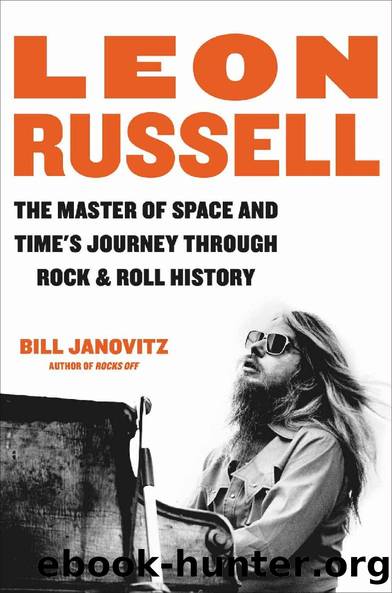Leon Russell by Bill Janovitz

Author:Bill Janovitz [Janovitz, Bill]
Language: eng
Format: epub
Publisher: Hachette Books
Published: 2023-03-14T05:00:00+00:00
Chapter 23
Stop All That Jazz
MARY JONES WALKED ONTO A plane in Tulsa with precious cargo: a Gibson Hummingbird acoustic guitar Bob Dylan had given Leon Russell. Leon had asked her to fly it down to Dallas, where he was performing a New Yearâs Eve show at Market Hall with Willie Nelson and Kinky Friedman. Jones joined them, Emily Smith, and the Tulsa crew for the final night of 1973. Leonâs foray into country music and his collaboration with Willie had been accepted as relatively novel and innovative, if not a giant step, by his audience of rock ânâ rollers. But he was about to go in an altogether different, perplexing direction.
Though he looked even older than he was, in the early 1970s, Leonâs actual age of thirty-one was considered old by rock ânâ roll standards. Impressed by the young musicians in the Gap Band, he not only would release their debut album Magicianâs Holiday on Shelter in 1974, but he would virtually adopt the group as his own for his next album, Stop All That Jazz, and they would be his backing band for all of his touring in â74. In keeping with the Shelter philosophy of having a Shelter act gain exposure on their lodestarâs tour, the Gap Band would also open the shows.
Coproduced by Buddy Jones (who also cowrote some songs) and Gap Band leader Charlie Wilson, Magicianâs Holiday glides through a constellation of funk, pop, and soul, with references to Sly and the Family Stone, Stevie Wonder, Billy Preston, and New Orleans artists like Allen Toussaint and the Meters. Though markedly different from their breakthrough in the eightiesâwith such synth-funk hits as âBurn Rubber on Meâ and âYou Dropped a Bomb on Me (Why You Wanna Hurt Me)ââtheir debut album displays a command that belies their rookie status. Leon contributes a repeating guitar riff on âFontessa Fame,â and Wayne Perkins plays solos on âBad Girlâ with fuzzy phased lead guitar inspired by Ernie Isleyâs distinctive tone on âThat Lady.â Leon returns on synth for the title track, which closes the album and is the song that owes the most to Stevie Wonderâs influence, specifically reminiscent of âYou and I,â from Wonderâs Talking Book. The Gap Band even had help on the album from Malcolm Cecil and Robert Margouleff, the same synth pioneers who worked with Wonder.
Stop All That Jazz was recorded in Leonâs home studio, the lake studio, and the Church. There was also one track recorded earlier in Nashville with Willie Nelson at Peteâs Place (Pete Drakeâs studio). J. J. Cale, drummer Karl Himmel, and steel guitar player Pete Drake joined other Nashville studio luminaries to rework the Tim Hardin song âIf I Were a Carpenter.â Leon managed to make an already cloying song worse. âI think Bobby Darin had just died,â Himmel said. Darin, who died December 20, 1973, had a hit with the song in 1966. A couple of weeks later, Tex Ritter died and Leon (who had played on a session or two
Download
This site does not store any files on its server. We only index and link to content provided by other sites. Please contact the content providers to delete copyright contents if any and email us, we'll remove relevant links or contents immediately.
The Goal (Off-Campus #4) by Elle Kennedy(13210)
Kathy Andrews Collection by Kathy Andrews(11342)
Diary of a Player by Brad Paisley(7272)
What Does This Button Do? by Bruce Dickinson(5937)
Assassin’s Fate by Robin Hobb(5866)
Big Little Lies by Liane Moriarty(5526)
Altered Sensations by David Pantalony(4872)
Pale Blue Dot by Carl Sagan(4631)
Sticky Fingers by Joe Hagan(3916)
The Death of the Heart by Elizabeth Bowen(3345)
The Heroin Diaries by Nikki Sixx(3327)
Beneath These Shadows by Meghan March(3156)
Confessions of a Video Vixen by Karrine Steffans(3106)
The Help by Kathryn Stockett(3023)
How Music Works by David Byrne(2969)
Jam by Jam (epub)(2882)
Harry Potter 4 - Harry Potter and The Goblet of Fire by J.K.Rowling(2816)
Strange Fascination: David Bowie: The Definitive Story by David Buckley(2703)
Petty: The Biography by Warren Zanes(2578)
